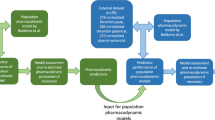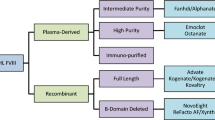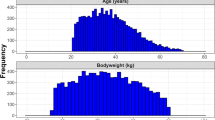Abstract
The aims of this study were to investigate the influence of total blood sampling time on the estimated pharmacokinetic parameters of Factor IX procoagulant activity (FIX:C) and to relate the pharmacokinetics of FIX:C to the putative physiological disposition of Factor IX (FIX). Six patients with severe haemophilia B each received 2 infusions of FIX and on both occasions blood samples were collected for 104 h. Each FIX:C decay curve was processed with successive deletion of the last (remaining) datapoint. The fitted terminal half-life (t1/2β) and the calculated model-independent mean residence time (MRTMI), elimination clearance (CLMI) and volume of distribution at steady state (Vss) stabilised close to their final values when FIX:C data corresponding to at least 56 h of sampling were used.
The final mean values were t1/2β=34 h, MRTMI=37 h, CLMI=4.0 ml · h-1 · kg-1 and Vss=0.15 l · kg-1. The disposition of FIX could be characterised by a two-compartment pharmacokinetic model. On average, FIX molecules spent 44% of their total MRT in the second (or “extravascular”) compartment. The distribution clearance was comparable to estimated total lymph flow. The volume of the central compartment was twice the estimated plasma volume, which may reflect the rapid and reversible binding of FIX to vascular endothelium. This explains the common clinical finding that the peak activity of FIX:C is less than the injected dose divided by the estimated plasma volume of the patient.
Similar content being viewed by others
References
Berntorp E, Björkman S, Carlsson M, Lethagen S, Nilsson IM (1993) Biochemical and in vivo properties of high purity factor IX concentrates. Thromb Haemost 70: 768–773
Björkman S, Carlsson M, Berntorp E, Stenberg P (1992) Pharmacokinetics of factor VIII in humans: obtaining clinically relevant data from comparative studies. Clin Pharmacokinet 22: 385–395
Boxenbaum HG, Riegelman S, Elashoff RM (1974) Statistical estimations in pharmacokinetics. J Pharmacokinet Biopharm 2: 123–148
Feldschuh J, Enson Y (1977) Prediction of the normal blood volume: relation of blood volume to body habitus. Circulation 56: 605–612
Gibaldi M, Perrier D (1982) Pharmacokinetics. 2nd edn. Dekker, New York
Giddings JC (1980) Hereditary coagulation disorders: laboratory techniques. In: Thomson JM (ed) Blood coagulation and haemostasis. Churchill Livingstone, New York, pp 117–157
Goldsmith JC, Kasper CK, Blatt PM, Gomperts ED, Kessler CM, Thompson AR, Herring SW, Novak PL (1992) Coagulation factor IX: successful surgical experience with a purified factor IX concentrate. Am J Hematol 40: 210–215
Heimark RL, Schwartz SM (1983) Binding of coagulation factors IX and X to the endothelial cell surface. Biochem Biophys Res Commun 111: 723–731
Heldebrant CM, Gomperts ED, Kasper CK, McDougal JS, Friedman AE, Hwang DS, Muchmore E, Jordan S, Miller R, Sergis-Davenport E, Lam W (1985) Evaluation of two viral inactivation methods for the preparation of safer factor VIII and factor IX concentrates. Transfusion 25: 510–515
Henthorn TK, Krejcie TC, Avram MJ (1992) The relationship between alfentanil distribution kinetics and cardiac output. Clin Pharmacol Ther 52: 190–196
Hoag MS, Johnson FF, Robinson JA, Aggeler PM (1969) Treatment of hemophilia B with a new clotting-factor concentrate. New Engl J Med 280: 581–586
Kim HC, McMillan CW, White GC, Bergman GE, Saidi P (1990) Clinical experience of a new monoclonal antibody purified factor IX: half-life, recovery, and safety in patients with hemophilia B. Semin Hematol 27: 30–35
Kim HC, McMillan CW, White GC, Bergman GE, Horton MW, Saidi P (1992) Purified factor IX using monoclonal immuno-affinity technique: clinical trials in hemophilia B and comparison to prothrombin complex concentrates. Blood 79: 568–575
Kong A-N, Jusko WJ (1988) Definitions and applications of mean transit and residence times in reference to the two-compartment mammillary plasma clearance model. J Pharm Sci 77: 157–165
Köhler M, Seifried E, Hellstern P, Pindur G, Miyashita C, Mörsdorf S, Fasco F, Wenzel E (1988) In vivo recovery and half-life time of a steam-treated factor IX concentrate in hemophilia B patients. Blut 57: 341–345
Lassen NA, Parving H-H, Rossing N (1974) Filtration as the main mechanism of overall transcapillary protein escape from the plasma (editorial). Microvasc Res 7: I-IV
Longo G, Cinotti S, Filimberti E, Giustarini G, Messori A, Morfini M, Rossi Ferrini P (1987) Single-dose pharmacokinetics of factor IX evaluated by model-independent methods. Eur J Haematol 39: 426–433
Menache D (1985) Coagulation factor IX concentrate: properties and clinical investigation (abstract). Thromb Haemost 54: 282
Morfini M, Lee M, Messori A (1991a) The design and analysis of half-life and recovery studies for factor VIII and factor IX. Thromb Haemost 66: 384–386
Morfini M, Longo G, Cinotti S, Filimberti E, Messori A, Rafanelli D, Mannucci PM (1991b) Comparative single-dose pharmacokinetic study of Alphanine vs Profilnine (abstract). Thromb Haemost 65: 1362
Nilsson IM, Berntorp E, Löfqvist T, Pettersson H (1992) Twenty-five years' experience of prophylactic treatment in severe haemophilia A and B. J Intern Med 232: 25–32
Noe DA, Bell WR, Ness PM, Levin J (1986) Plasma clearance rates of coagulation factors VIII and IX in factor-deficient individuals. Blood 67: 969–972
Rossing N (1978) Intra- and extravascular distribution of albumin and immunoglobulin in man. Lymphology 11: 138–142
Smith KJ, Thompson AR (1981) Labeled factor IX kinetics in patients with hemophilia-B. Blood 58: 625–629
Stern DM, Drillings M, Nossel HL, Hurlet-Jensen A, LaGamma KS, Owen J (1983) Binding of factors IX and IXa to cultured vascular endothelial cells. Proc Natl Acad Sci USA 80: 4119–4123
Thompson AR (1986) Structure, function, and molecular defects of factor IX. Blood 67: 565–572
Thompson AR (1993) Factor IX concentrates for clinical use. Semin Thromb Haemost 19: 25–36
Zauber NP, Levin J (1977) Factor IX levels in patients with hemophilia B (Christmas disease) following transfusion with concentrates of factor IX or fresh frozen plasma (FFP). Medicine 56: 213–224
Author information
Authors and Affiliations
Rights and permissions
About this article
Cite this article
Björkman, S., Carlsson, M. & Berntorp, E. Pharmacokinetics of factor IX in patients with haemophilia B. Eur J Clin Pharmacol 46, 325–332 (1994). https://doi.org/10.1007/BF00194400
Received:
Accepted:
Issue Date:
DOI: https://doi.org/10.1007/BF00194400




